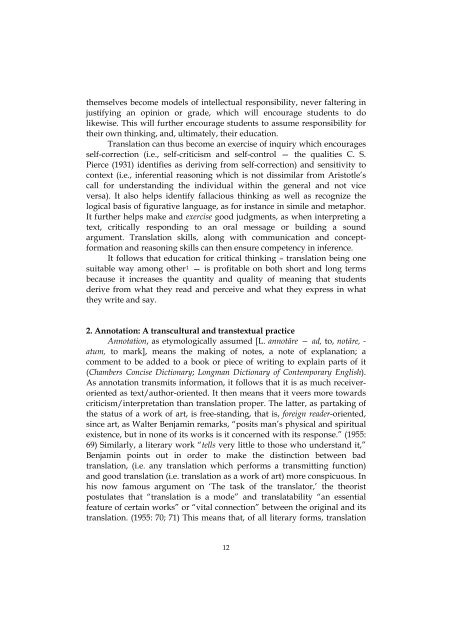translation studies. retrospective and prospective views
translation studies. retrospective and prospective views
translation studies. retrospective and prospective views
You also want an ePaper? Increase the reach of your titles
YUMPU automatically turns print PDFs into web optimized ePapers that Google loves.
themselves become models of intellectual responsibility, never faltering in<br />
justifying an opinion or grade, which will encourage students to do<br />
likewise. This will further encourage students to assume responsibility for<br />
their own thinking, <strong>and</strong>, ultimately, their education.<br />
Translation can thus become an exercise of inquiry which encourages<br />
self-correction (i.e., self-criticism <strong>and</strong> self-control — the qualities C. S.<br />
Pierce (1931) identifies as deriving from self-correction) <strong>and</strong> sensitivity to<br />
context (i.e., inferential reasoning which is not dissimilar from Aristotle’s<br />
call for underst<strong>and</strong>ing the individual within the general <strong>and</strong> not vice<br />
versa). It also helps identify fallacious thinking as well as recognize the<br />
logical basis of figurative language, as for instance in simile <strong>and</strong> metaphor.<br />
It further helps make <strong>and</strong> exercise good judgments, as when interpreting a<br />
text, critically responding to an oral message or building a sound<br />
argument. Translation skills, along with communication <strong>and</strong> conceptformation<br />
<strong>and</strong> reasoning skills can then ensure competency in inference.<br />
It follows that education for critical thinking – <strong>translation</strong> being one<br />
suitable way among other 1 — is profitable on both short <strong>and</strong> long terms<br />
because it increases the quantity <strong>and</strong> quality of meaning that students<br />
derive from what they read <strong>and</strong> perceive <strong>and</strong> what they express in what<br />
they write <strong>and</strong> say.<br />
2. Annotation: A transcultural <strong>and</strong> transtextual practice<br />
Annotation, as etymologically assumed [L. annotāre — ad, to, notāre, -<br />
atum, to mark], means the making of notes, a note of explanation; a<br />
comment to be added to a book or piece of writing to explain parts of it<br />
(Chambers Concise Dictionary; Longman Dictionary of Contemporary English).<br />
As annotation transmits information, it follows that it is as much receiveroriented<br />
as text/author-oriented. It then means that it veers more towards<br />
criticism/interpretation than <strong>translation</strong> proper. The latter, as partaking of<br />
the status of a work of art, is free-st<strong>and</strong>ing, that is, foreign reader-oriented,<br />
since art, as Walter Benjamin remarks, “posits man’s physical <strong>and</strong> spiritual<br />
existence, but in none of its works is it concerned with its response.” (1955:<br />
69) Similarly, a literary work “tells very little to those who underst<strong>and</strong> it,”<br />
Benjamin points out in order to make the distinction between bad<br />
<strong>translation</strong>, (i.e. any <strong>translation</strong> which performs a transmitting function)<br />
<strong>and</strong> good <strong>translation</strong> (i.e. <strong>translation</strong> as a work of art) more conspicuous. In<br />
his now famous argument on ‘The task of the translator,’ the theorist<br />
postulates that “<strong>translation</strong> is a mode” <strong>and</strong> translatability “an essential<br />
feature of certain works” or “vital connection” between the original <strong>and</strong> its<br />
<strong>translation</strong>. (1955: 70; 71) This means that, of all literary forms, <strong>translation</strong><br />
12












